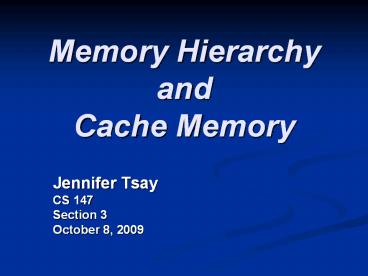Memory Hierarchy and Cache Memory PowerPoint PPT Presentation
1 / 20
Title: Memory Hierarchy and Cache Memory
1
Memory Hierarchy and Cache Memory
- Jennifer Tsay
- CS 147
- Section 3
- October 8, 2009
2
Two Basic Types of Memory
- RAM (Random Access Memory)
- Used to store programs and data that computer
needs when executing programs - Volatile and loses information once power is
turned off
3
2 Basic Types of Memory
- ROM (Read-Only Memory)
- Stores critical information necessary to operate
the system, such as program necessary to boot
computer - Not volatile and always retains its data
- Also embedded in systems where programming does
not need to change
4
Memory Hierarchy
- Hierarchal Memory
- Approach in which computer systems use
combination of memory types to provide best
performance at best cost - Basic types that constitute hierarchal memory
system include registers, cache, main memory and
secondary memory
5
Memory Hierarchy
- Todays computers each have small amount of very
high-speed memory, called cache where data from
frequently used memory locations may be
temporarily stored - Cache is connected to main memory, which is
typically medium-speed memory - Main memory is complemented by secondary memory,
composed of hard disk and various removable media
6
The Memory Hierarchy
7
How Do We Classify Memory?
- Based on its distance from the processor
- Distance is measured by the number of machine
cycles required for access - The closer memory is to the processor, the faster
it should be
8
Locality of Reference
- Clustering of memory references into groups
- Important because through use of cache technique,
locality of reference can optimize performance
9
Cache Memory
- Small, temporary, but fast (and thus high-cost)
memory - Processor uses cache memory for information it is
likely to need again in very near future - Non-computer Examples
- Cell Phone Address Book vs. Phone Book
- Desk vs. File Cabinet
10
- MAIN MEMORY
- CACHE
11
Cache Mapping Schemes
- For cache to be functional, it must store useful
data - This data becomes useless if CPU cant find it
- When accessing data or instructions, the CPU
first generates main memory address - If data has been copied to cache, address of data
in cache is not same as main memory address
12
Types of Mapping Schemes
- Direct Mapped Cache
- Each main memory block has specific location to
which it maps in cache - If block already occupies cache location where
new block must be placed, block currently in
cache is removed
13
Types of Mapping Schemes
- Fully Associative Cache
- Allows main memory block to be placed anywhere in
cache - When cache is full, need replacement algorithm to
decide which block to throw out of cache
14
Replacement Algorithms
- LRU (Least Recently Used)
- Keep track of the last time each block was
accessed - Select the block that has been used least
recently to be the block that gets removed - Requires system to keep history of accesses for
every cache block which requires significant
space and slows down operation of cache - FIFO (First-in, First out)
- Block that has been in cache the longest
(regardless of how recently it has been used)
would be selected as block to be removed from
cache memory
15
Measuring Performance
- How do we measure performance of two-level
hierarchical memory? - By its Effective Access Time (EAT), or average
time per access - EAT H x AccessC (1 H) x AccessMM
- H cache hit rate AccessMM main memory access
time - AccessC cache access time
16
Example
- Lets say that
- AccessC 10ns
- AccessMM 200ns
- H 99
- EAT H x AccessC (1 H) x AccessMM
- EAT 0.99 x 10ns (0.01) x 200ns 12ns
17
Cache Writing Policies
- Designers have to determine what to do with
blocks that have been modified - Cache write policy determines when actual main
memory block is updated to match cache block - Write-Through
- Updates both cache and main memory simultaneously
on every write - Write-back
- Only updates blocks in main memory when cache
block is selected to be removed from cache
18
Data and Instruction Caches
- Data Cache
- Instruction Cache
- Advantages of separating
- Unified cache has only one port for data and
instructions, resulting in conflicts between the
two - Allows accesses to be less random and more
clustered
19
Levels of Cache
- Multilevel Cache Memory
- Caches using caches for increased performance
- Level 1 (L1) cache is term used for cache
resident on chip and is fastest, smallest cache - L1 is always checked first, but if the data is
not found in L1, L2 cache is checked - L3 cache refers to extra cache between processor
and memory on processors
20
References
- http//en.wikipedia.org/wiki/Locality_of_reference
- http//images.google.com/url?sourceimgresctref
qhttp//www.viewpoints.com/HON-210-Series-28-1-2-
Deep-Vertical-File-Cabinet-review-a897usgAFQjCNF
ogrb2UbcND7bTPbDviC8DvlTpeQ - http//i.ehow.com/images/GlobalPhoto/Articles/4799
688/IMGP1527edited-1-main_Full.jpg - www.leoncountyfl.gov/recycling/
- www.calgary-city-maps.com/Calgary-phone-book.html
- tjliu.myweb.hinet.net/COA_CH_6.htm
- http//www.kidscreen.com/planetpreschool/wp-conten
t/uploads/2009/08/2_mel-at-messy-desk.jpg - http//images.google.com/url?sourceimgresctref
qhttp//www.novopc.com/2008/09/ram-random-access-
memory/usgAFQjCNF9SaCi-7adm2Vu2fdpZF-hNVu4sw - Null, L. Lobur, J. The Essentials of Computer
Organization and Architecture. 2006 Sudbury.

